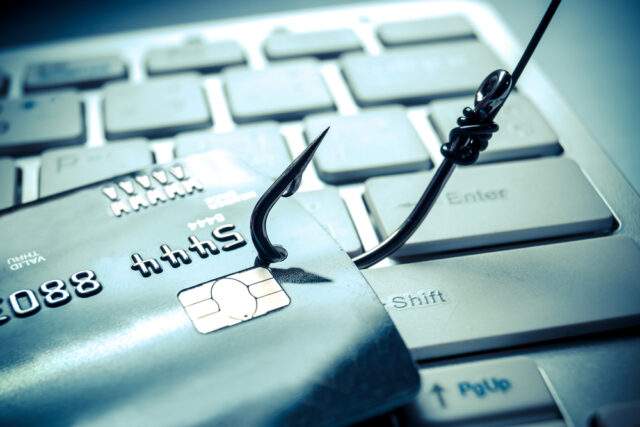Vishing: everything you need to know
Read our guide to find out what vishing is, how it works, why it exists & how to identify, respond to, recover from & prevent it.
Read our guide to find out what vishing is, how it works, why it exists & how to identify, respond to, recover from & prevent it.

Fake emails and suspicious SMS messages are easy to spot, but we often overlook the potential dangers of voice messages and phone calls. Cyber criminals are well aware of this blind spot, and they’re rapidly evolving their vishing techniques in order to exploit it.
Their tactics have grown increasingly sophisticated, making it harder to detect their malicious intentions. As the prominence of vishing attacks increases, it becomes crucial for organizations and individuals to remain vigilant.
In this guide, we will cover everything you need to know, including:
Vishing, short for “voice phishing,” is a deceptive practice. Scammers use voice calls to manipulate and deceive individuals in order to extract sensitive personal information or financial details. It is a form of social engineering that capitalizes on human trust and vulnerability over the phone.
The goal of vishing attacks is to obtain sensitive data like credit card information, Social Security numbers, login credentials, or other personally identifiable data that can be exploited for financial gain or identity theft. Once victims take the bait, bad actors can carry out fraudulent transactions, access accounts, or even sell their data on the black market.
Phishing, vishing, and smishing share the same goal, but their attack vectors differ. Let’s explore this in greater detail.
Phishing uses fraudulent emails to trick individuals into revealing sensitive information. Phishing attacks also involve sending malicious attachments or links that, when clicked, install malware on the victim’s device.
Vishing is a social engineering attack conducted over the phone or through voice messages. They may request personal information, such as credit card numbers and social security numbers, or ask victims to visit fraudulent websites and provide access to their computer systems.
Smishing refers to phishing attacks conducted through instant messaging platforms, such as SMS, WhatsApp and Facebook Messenger. These messages often contain urgent or enticing requests, such as account verification or prize notifications. It can also include malicious links or fraudulent phone numbers.
Vishing attacks vary depending on the target, and scammers adapt their tactics to exploit unique vulnerabilities and manipulate victims effectively. However, most attacks follow a similar pattern.
The attacker initiates contact with the victim through a phone call or a voicemail message. They often pretend to be a trusted organization or individual, such as a bank representative, government official, or technical support agent.
The attacker employs manipulative tactics to gain the victim’s trust and create a sense of urgency or importance. They might claim there is a security issue with the victim’s account or offer exclusive deals or rewards.
Attackers request sensitive information such as credit card numbers, social security numbers, login credentials, or other personal details. They may ask the victim to provide this information directly over the phone or to visit a fraudulent website and enter the information.
After obtaining the sensitive information, the attacker can use it for various malicious purposes, such as identity theft, financial fraud, unauthorized account access, or selling the information on the black market.
Scammers employ various techniques to make vishing attacks more convincing and increase their chances of success. Here are some common techniques used by vishing scammers:
Vishing attacks are performed for various malicious purposes and they’re increasingly common due to their high success rate. Here are a few reasons why scammers engage in vishing attacks:
From financial losses to legal consequences, vishing attacks can be make or break for organizations. Here are some of the most significant consequences:
If scammers access sensitive financial information or deceive employees into transferring funds, the organization may suffer monetary damages. Additionally, there are costs associated with investigating the attack, implementing security measures, and potentially compensating affected clients.
Successful vishing attacks can result in the compromise of sensitive data, such as client information, employee records, or intellectual property. This can lead to reputational damage and loss of trust from clients.
News of the attack, especially if client data was compromised, can spread quickly, and erode trust in the organization’s ability to protect sensitive information. This can lead to client attrition, negative public perception, and a decline in business.
Organizations that fail to protect client data adequately or comply with data protection regulations may face legal consequences. Organizations may be subject to fines, penalties, or legal action from regulatory bodies or affected individuals.
If scammers gain unauthorized access to systems or accounts, they may engage in malicious activities that disrupt normal business operations, compromise IT infrastructure, or introduce malware that spreads across the network.
Valuable research, development plans, marketing strategies, or other sensitive business information may fall into the wrong hands. If so, organizations may lose their competitive advantage.
Vishing attacks can take various forms and target individuals or organizations in different ways, here are a few real-world examples:
Scammers pose as tech support agents from major companies like Microsoft or Apple, claiming computer or software issues. They deceive victims into granting remote access or sharing sensitive data to resolve the problem, but instead gain unauthorized access or steal financial information.
Bad actors impersonate IRS representatives, pressuring victims to pay alleged outstanding taxes or fines. Threats of legal action or arrest coerce victims into immediate payments or sharing sensitive information. The IRS never initiates contact via phone or demands instant payments.
Vishers impersonate bank employees, raising concerns about suspicious account activity or the need for account verification. They then request personal data, such as account numbers or social security numbers, to purportedly resolve the issue. The obtained information facilitates unauthorized account access or identity theft.
Targeting employees in organizations, scammers pose as top executives, like CEOs or CFOs. They contact employees, particularly from finance departments, with a sense of urgency, requesting urgent wire transfers or sensitive financial details. Exploiting their executive position, these scammers deceive employees into complying with their fraudulent requests.
Identifying vishing attacks can be challenging since scammers employ tactics to appear legitimate. Here are some tips to consider:
When an organization becomes aware of a vishing attack or suspects that it has been targeted, it’s crucial to respond promptly and effectively. Here are some recommended steps:
Record the attack details, including the date, time, and phone number(s) used by the attacker. Report the incident to the relevant authorities.
Notify employees about the vishing attack, providing details of the incident and the tactics used by the attackers. Consider conducting training sessions or awareness campaigns.
Provide information about the incident, the potential impact on their data, and any measures being taken to address the situation. Offer guidance on how clients can protect themselves and monitor their accounts for suspicious activity.
Investigate the extent of the vishing attack, identify any compromised systems or accounts, and assess the potential damage. Involve IT and security teams to gather information about the attack and its impact.
Activate the incident response plan and follow the established procedures to contain the incident, mitigate the impact, and restore normal operations.
Once you’ve swiftly responded to a phishing attack, it’s time to recover and restore normal operations. Here’s what you should do:
Isolate compromised systems or accounts to prevent further unauthorized access or data exfiltration. Change passwords, revoke access privileges, and disable compromised accounts.
Analyze logs, network traffic, and any available evidence to identify the attack vector, compromised systems, and the data or information that may have been accessed or stolen.
Implement security measures like multi-factor authentication, enhanced access controls, and regular security audits and assessments. Consider engaging third-party experts to perform penetration testing or security assessments.
Review security and data protection policies to ensure they address the lessons learned from the vishing attack. Update as necessary to reflect new threats and vulnerabilities, and to align with industry best practices and compliance requirements.
Restore systems and data from secure backups, ensuring they are free from any compromise. Regularly test backup processes to ensure their effectiveness in the event of future incidents. Consider implementing additional safeguards, such as off-site backups or cloud-based recovery solutions.
Perform a post-incident analysis to evaluate the organization’s response, identify areas for improvement, and update incident response plans accordingly. Learn from the attack to enhance the organization’s security posture and resilience against future vishing attacks.
Preventing and protecting an organization from vishing attacks requires a multi-layered approach that combines technical measures, employee education, and robust security practices. Here are some key steps:
Train employees on the risks of vishing attacks, and how to recognize and report suspicious calls. Emphasize the importance of verifying the identity of callers, not disclosing information over the phone, and following security protocols.
Implement MFA for accessing critical systems, accounts, and sensitive information. This adds an extra layer of protection by requiring additional verification in addition to regular login credentials.
Implement caller authentication mechanisms within the organization’s phone system. This includes voice biometrics or secure caller identification to verify the authenticity of calls.
Utilize robust spam filters and call-blocking technologies to identify and block suspicious calls or messages. These tools can reduce the number of vishing attempts that reach employees.
Implement call analytics and monitoring systems to identify suspicious call patterns or anomalies. Unusual call volumes, high frequency calling from specific numbers, or other patterns may indicate potential attacks.
Develop an incident response plan specifically addressing vishing attacks. Establish clear procedures for identifying, containing, and mitigating incidents. Ensure the plan includes communication channels, roles and responsibilities, and coordination with relevant stakeholders.
Create a culture where employees feel comfortable reporting suspicious calls or messages. Establish clear channels for reporting potential vishing attempts and encourage employees to do so.
Conduct regular security assessments, penetration testing, and vulnerability scans to identify and address any weaknesses in the organization’s systems and processes. This can help identify potential entry points or vulnerabilities that attackers could exploit.
Regularly update and patch software, systems, and applications to address known vulnerabilities. Keeping systems up to date reduces the risk of exploitation by attackers seeking to gain access through vishing attacks.
Share information and best practices with other organizations in your industry to stay informed about emerging threats and mitigation strategies. Participate in industry forums, security communities, and information-sharing initiatives.
What may seem like an obvious vishing attack today may be harder to identify tomorrow. Bad actors are continuously evolving their tactics and becoming more sophisticated in the process.
As you improve your security posture, remember to stay vigilant and adaptable. Secure your data, protect your reputation, and always remain a step ahead of potential threats.
At CovertSwarm, we are committed to helping organizations stay proactive and informed. If you need further advice regarding vishing or other cybersecurity matters, feel free to reach out to a member of our team.

What is social engineering in cybersecurity?
Discover the ins and outs of social engineering attacks and learn how to identify and prevent them with this comprehensive guide from CovertSwarm.

What is smishing and how do you prevent it?
Read our guide to find out what smishing is, different types, why it’s a problem for organizations and how to prevent it.

What is phishing and how can you prevent it?
Read our complete guide to learn what phishing is, different types of attack, how it works and how to prevent it